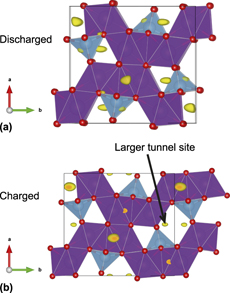Article contents
Using in situ synchrotron x-ray diffraction to study lithium- and sodium-ion batteries: A case study with an unconventional battery electrode (Gd2TiO5)
Published online by Cambridge University Press: 04 November 2014
Abstract

Designing materials for application as electrodes in sodium-ion batteries may require the use of unconventional materials to realize acceptable reversible sodium insertion/extraction capabilities. To design new materials simple electrochemical methods need to be coupled with other techniques such as in situ x-ray diffraction (XRD) to correlate the influence of electrochemical performance on a parameter that can be modified, e.g., the crystal structure of the material. Here we use in situ synchrotron XRD data on Gd2TiO5-containing cells to show the minor changes in reflection positions during discharge/charge that illustrates minimal volume expansion and contraction due to insertion/extraction reactions. These small changes correlate to the Gd2TiO5 anode material in both lithium- and sodium-ion batteries showing reversible capacities of ∼45 and ∼23 mA h/g after 20 cycles, respectively. Analysis of sodium location in the crystal structure shows a preference for sodium in the smaller channels along the c axis direction during the first discharge before moving to the larger channels at the charged state. Therefore, in this work, in situ studies highlight minimal structural changes with respect to volume expansion during electrochemical cycling and illustrate where sodium ions locate within the Gd2TiO5 structure.
- Type
- Articles
- Information
- Journal of Materials Research , Volume 30 , Issue 3: Focus Issue: In-situ and Operando Characterization of Materials , 14 February 2015 , pp. 381 - 389
- Copyright
- Copyright © Materials Research Society 2014
References
REFERENCES
- 12
- Cited by




